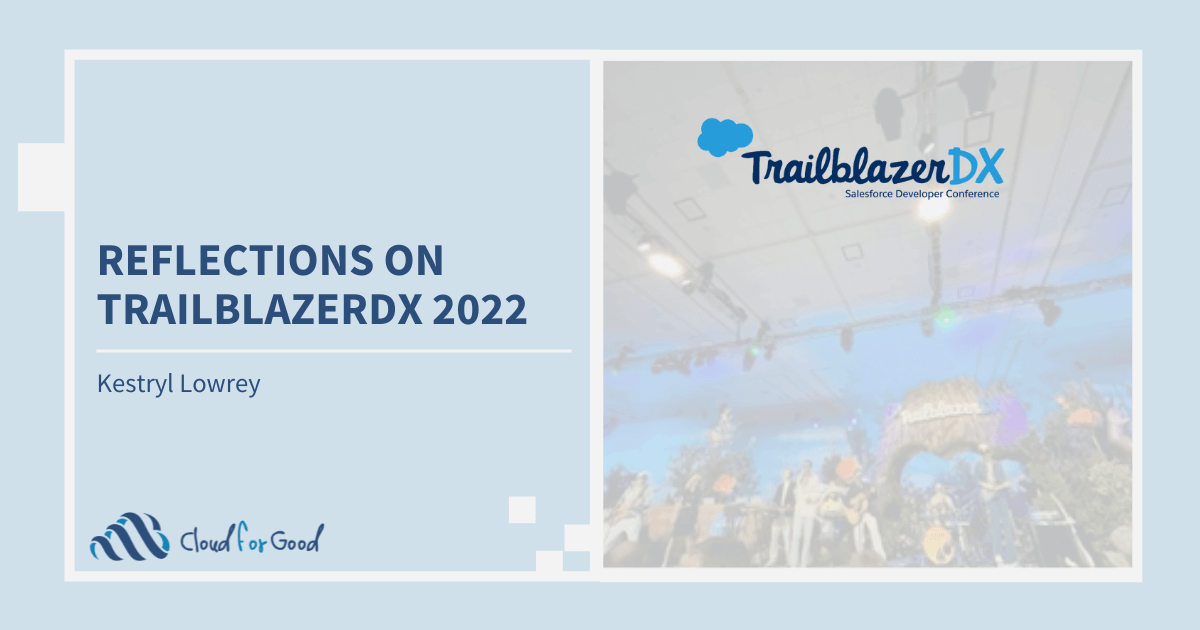At the end of April, Salesforce developers, integration and analytics experts, and architects converged in San Francisco for two days of workshops and sessions at TrailblazerDX (TDX), Salesforce’s developer conference. Featuring the core Salesforce platform, as well as Mulesoft, Tableau, and Slack, TDX is an opportunity to learn more about the technical side of the platform. The conference brought announcements of new features expected to release in the coming year and inspired ideas of how organizations could leverage Salesforce tools in their digital transformations.
Several architects and technical leaders from Cloud for Good attended the conference to expand their knowledge and learn what’s next for Salesforce. Here are their key takeaways and highlights from the event.

Platform
Salesforce is investing time in more consistent integration of its full suite of solutions. In the future, we can expect tighter integration and more support for Salesforce work done in places other than Salesforce. The future is Salesforce the portfolio – Slack, AWS, and many others. The messaging during the keynote was that this is intentional and part of the plan for what the user experience is expected to be.
Some of this brings expanded support for Flow automation solutions beyond the bounds of the core platform, such as in Slack and Tableau. Flow also continues to level up with enhanced tooling to support advanced automation use cases implemented by non-developers, with the addition of unit testing for flows. Dynamic forms for custom objects and enhancements for list views were also called out during the True to the Core session, continuing to expand the configurability of the core platform user experience in Lightning. Additionally, Salesforce Functions continue to expand options for elastic compute power for resource-intensive jobs, allowing developers to leverage code running outside of Salesforce to augment work occurring in the CRM.

Integration
On the integrations front, Mule continues to invest in better user experience, more declarative power, better knowledge bases, and learning experiences. Mule will continue to be a core part of Salesforce integration strategies, and new tools such as Flow Robotic Process Automation (Flow RPA) will expand options for how organizations can interact with external systems.
Announcements about AWS integration options were also significant. AWS Event Relays will enable low-code native event-based integration between the Salesforce platform and AWS EventBridge, allowing organizations to leverage a scalable cloud architecture. Support for AWS in Salesforce Connect will allow data stored in Amazon DynamoDB to be exposed on external objects in Salesforce, allowing for a virtualized integration for organizations with high data volume.

Analytics
Tableau was another focus of the conference. Tableau is focused on granting users access to answers quicker, from more places, focused around getting answers in the hands of users quicker, and enabling the power users to be better storytellers about their data. New connectivity with S3 and other sources is exciting, reducing reliance on data engineers to prep data prior to pulling into Tableau. Increasingly, Tableau is appearing as the ‘single source of insight’ – instead of the more traditional approach of curated data from Data Architects/Engineers. There is continued investment and feature enablement driving the power of the tool to transform on the fly to answer business questions as needed, rather than relying on static, planned dashboards.
Any advanced analytics tool needs access to data from diverse sources. Announcements at TDX included new approaches and strategies for data management, such as using Mulesoft to set up System APIs and Process APIs to feed data to Tableau, or using Tableau Prep, an ETL tool, to aggregate and transform data from multiple sources that could then be provided to Tableau for analytics.

Slack
Slack continues to develop as a core system of engagement. New features will allow users to launch Salesforce flows and interact with Salesforce records directly in Slack, as well as the ability to automate actions in Slack from Salesforce Flows. While it isn’t here yet, the conference presentations pointed to a future where work and collaboration related to data in the CRM happens in Slack—not in Chatter.

Skill Development
Salesforce continues to expand pathways for Salesforce professionals to expand and validate their skills. TDX brought announcements of new certifications that provide recognition and definition of business/technical hybrid roles. Salesforce Certified Business Analyst and Salesforce Certified Strategy Designer have been added to the official certification path – roles that are well defined in the partner ecosystem but haven’t had an official certification until now.
Additionally, new Ranger Ranks were announced. Previously, on Trailhead, the highest rank a Trailblazer could achieve was Ranger, after completing 100+ badges and 50K+ points. Now, there are expanded ranks beyond that, represented as multi-star rangers (ex. Double Star Ranger, Triple Star Ranger, and so on). This both acknowledges Trailblazers who have already gone far beyond the initial Ranger badge, as well as gives newer Trailblazers extended goals to aim for!

Overall, TrailheadDX provided an opportunity to learn more about exciting new developments on the platform and think strategically about digital transformation. If you’re curious about any of the new announcements from TrailheadDX and how they could improve your organization’s business processes and efficiency, please contact us to start a conversation about your vision.





